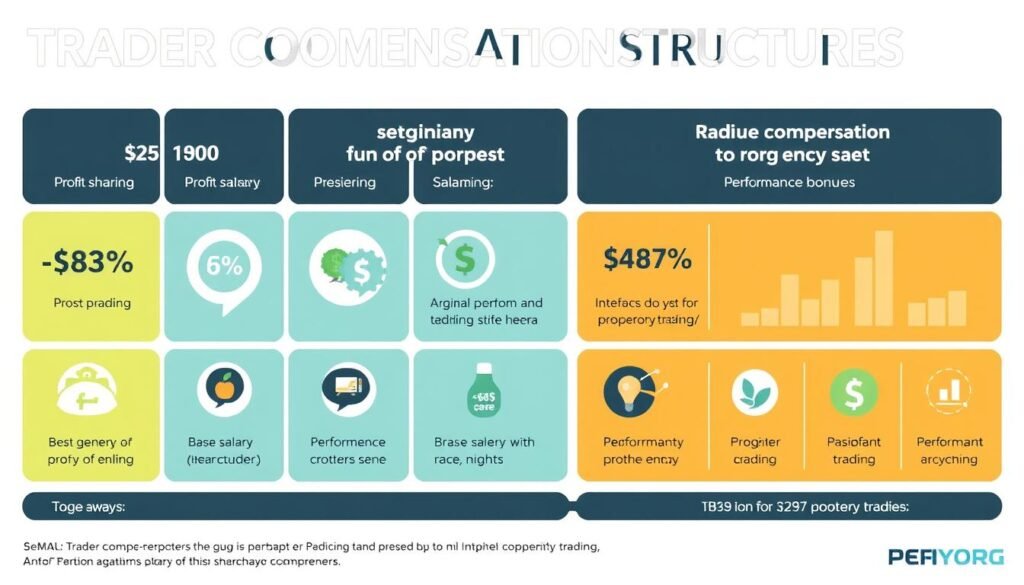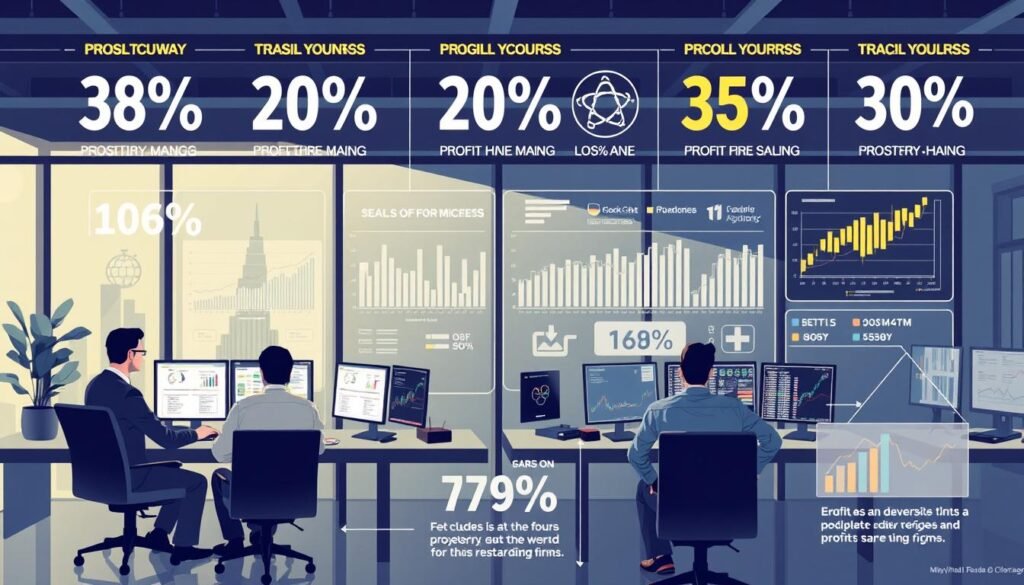Ever wondered what drives the financial markets? Proprietary trading firms are at the heart of it all. They are key players, but their role is often shrouded in mystery. So, what exactly is a Prop Firm in Trading and how does it work?
This guide will shed light on these enigmatic firms. You’ll learn about their role in the financial world. It’s a world where risk, profit, and skill come together.
As we dive deeper, you’ll see how these firms operate. From the tech they use to how they evaluate their traders. Whether you’re interested in joining or just curious, this guide has what you need to know.
Key Takeaways
- An understanding of how proprietary trading firms use their own capital to interact with financial markets.
- An introduction to the guide that demystifies the operational framework of prop firms.
- Insights into the elements, such as risk and trader evaluation, that are vital to the success of prop firms.
- Preview of topics on technological infrastructure, profit-sharing models, and trading strategies utilized by proprietary trading firms.
- Background knowledge fostering a closer look at the prop trading industry from historical, regulatory, and modern perspectives.
The Evolution of Proprietary Trading Firms
The history of proprietary trading is closely tied to the financial markets. Over time, these firms have changed a lot. They’ve been shaped by big changes in rules and new technology.
The Historical Context of Prop Trading
Proprietary trading, or prop trading, started with financial institutions trading with their own money. They traded stocks, bonds, and more to make a profit. This has always been a key part of their work, offering big risks and rewards.
These operations have grown and changed over the years. They’ve adapted to different market conditions and rules.
Regulatory Shifts and their Impact on the Industry
Rules have always been important for prop trading. The Glass-Steagall Act of 1933, for example, stopped some banks from trading in certain ways. Later, the Gramm-Leach-Bliley Act in 1999 let them do more.
But, the 2010 Dodd-Frank Act and the Volcker Rule put limits back on. These rules have changed how firms trade and plan for the future.
Modern Day Prop Trading Firms
Today, these firms are very advanced. They use new technology to trade fast and in big volumes. They use smart algorithms and models to make decisions.
This change shows how trading has moved from manual to automated. Firms also have to deal with many rules that affect their daily work and plans.
| Year | Regulation | Impact on Prop Trading |
|---|---|---|
| 1933 | Glass-Steagall Act | Limited certain types of proprietary trading |
| 1999 | Gramm-Leach-Bliley Act | Deregulation allowing more prop trading activities |
| 2010 | Dodd-Frank Act – Volcker Rule | Restricted banks from engaging in prop trading |
What is a Prop Firm in Trading and How Does It Work?
Proprietary trading firms, or prop firms, give traders capital to trade in stocks, commodities, and currencies. They make money directly from trading, unlike brokerages that charge commissions. It’s key to know how these firms work for those interested in trading.
Prop firms make it easier for skilled traders to enter the market by reducing trading capital requirements. They carefully check trader performance evaluation using advanced metrics. This helps in improving trading strategies.
Traders get access to top-notch trading tools and technology from prop firms. They must meet high standards of risk and fund management. The more a trader performs well, the more capital they get, leading to bigger financial gains.
- Capital Allocation: Traders get different amounts of capital based on their experience and past performance.
- Risk Control: Firms have strict risk evaluation to reduce losses and use opportunities.
- Profitability: Traders make profits for the firm, which helps their career and pay.
Prop trading firms focus on growth and accountability. They evaluate trader performance and manage capital well. This makes them competitive and adaptable in the financial trading world.
Distinctive Features of Proprietary Trading Firms
Proprietary trading firms are different from traditional investment firms. They focus on specific areas of the financial markets. They use advanced trading technology to make more money.
Differences from Traditional Investment Firms
In the competitive world of proprietary trading vs investment firms, prop firms have an advantage. They trade with their own money, not client funds. This lets them take bigger risks and use bold strategies without worrying about investors.
Technology and Infrastructure Used by Prop Firms
Top-notch trading technology is key for prop firms. They spend a lot on the latest hardware and software. This helps them trade fast, analyze lots of data, and automate complex strategies.
They use advanced tech to stay ahead in the fast financial world. This lets them make money from small market gaps that manual traders can’t catch.
Specialization in Financial Instruments
Prop firms often focus on specific areas of financial markets specialization. Some might only deal with derivatives, while others focus on commodities or emerging market stocks. This focus helps them develop deep knowledge and strategies tailored to these markets.
Assessing Trader Performance Evaluation in Prop Firms
In the world of proprietary trading, checking how well traders do is key. This process helps see if traders are doing well and helps them grow in their careers. Prop firms use trader performance metrics, watch traders closely, and understand trading psychology to help traders succeed.
Criteria for Evaluating Traders
Prop firms look at many things when they check how traders are doing. They check if traders are making money, managing risk well, and adjusting to market changes. These checks make sure traders face real challenges every day.
Continuous Monitoring and Performance Feedback
Prop firms use new tech to watch traders all the time. This lets them give feedback quickly. This feedback helps traders get better and grow.
Role of Statistical Metrics and Trading Psychology
Numbers help figure out how well traders are doing. But trading psychology looks at the soft skills too. It helps see how traders handle stress and make choices.
| Performance Metric | Description | Impact on Trader Evaluation |
|---|---|---|
| Profit & Loss | Total earnings versus total losses over a specific period. | Directly reflects financial efficacy and risk management skills. |
| Risk-Reward Ratio | Measures the expected returns of a trade against the risk of potential losses. | Assesses trader’s ability to manage risk effectively. |
| Psychological Resilience | Evaluation of how traders handle stress and make decisions under pressure. | Indicates adaptability and potential for long-term success within high-stress environments. |
Putting all these parts together helps make a better way to check how traders are doing. This way, prop firms can find and grow top traders. These traders can do well in the fast and changing world of trading.
Trader Compensation Structures in Prop Trading
In the world of proprietary trading, trader compensation structures are key to getting and keeping the best traders. Firms differ a lot in how they pay their traders. Many use profit-sharing models to match the trader’s goals with the firm’s.

Prop trading stands out because of its flexible pay. Unlike jobs with set salaries, prop traders get a share of their profits. This way, they earn more when they do well, which helps the firm too.
- Base Salary + Commission: Some firms give a base salary plus a commission on profits. This mix offers stability and rewards for doing well.
- Pure Profit Sharing: Other firms give a bigger share of profits, without a base salary. This can be very rewarding for top traders.
- Graduated Revenue Splits: In this setup, the share of profits grows as the trader makes more money.
Choosing the right trader compensation structures depends on the market and the trader’s performance. Prop firms keep checking and tweaking their pay plans. They want to stay competitive and make sure their traders are happy and well-paid.
As prop trading grows, so do the profit-sharing models. Firms keep finding new ways to pay their traders. They adjust trader revenue splits to keep both traders and the firm happy and profitable.
Understanding Funded Trader Programs
Funded trader programs let traders start trading without needing their own money. These programs look for skilled traders and give them the money to trade. This way, they can use their knowledge without risking their own money.
How Funded Trader Programs Operate
These programs give traders a certain amount of money to trade with. They watch how well the trader does and make sure they follow rules. If a trader does well, they might get more money or share in the profits.
Benefits and Risks for Traders
Trading with funded programs has big benefits and risks. Traders get to use more money and can make more money. They also learn from experienced traders. But, there’s pressure to perform well and the chance of losing money, which could hurt their career.
Key Considerations Before Participating
Before joining a funded trader program, check if it’s trustworthy and clear about how it works. Know how profits are split and any fees. This helps set realistic goals.
| Aspect | Consideration | Implication |
|---|---|---|
| Capital Allocation | Amount of initial trading capital | Higher capital might offer more trading flexibility but can come with steeper targets and possible stresses. |
| Risk Management | Strictness of rules | More stringent rules help manage risks more effectively, but could restrict trading strategies. |
| Profit-Sharing | Percentage split between firm and trader | Favorable splits can significantly enhance earnings, but often come with high performance expectations. |
| Training and Support | Availability of professional guidance | Essential for improving trading skills, particularly for new traders in adapting to market conditions. |
Prop Firms Pros and Cons
Proprietary trading firms offer unique opportunities and challenges. It’s important to understand both the advantages of prop firms and the challenges in proprietary trading before starting this career.
Advantages of Prop Firms
- Access to extensive capital, allowing traders to leverage larger volumes than they could with personal accounts.
- Advanced trading technologies and infrastructure that might be prohibitive in cost for individual traders.
- Intensive training programs that help in developing refined trading strategies and risk management skills.
Challenges in Proprietary Trading
- The pressure of meeting performance benchmarks to continue accessing firm resources.
- High dependency on market fluctuations, which can significantly affect profitability.
- Potential conflicts of interest in trade execution priorities, particularly with large prop trading entities.
Prop Trading Assessment
Success in proprietary trading depends on skill and adaptability. The prop trading assessment evaluates decision-making speed, emotional control, and market anticipation. These skills can lead to great opportunities or block new traders.
Traders must weigh the advantages of prop firms and the challenges in proprietary trading against their career goals. The fast-changing world of proprietary trading demands adaptability and continuous learning for success.
Proprietary Trading Strategies and Tactics
In the world of financial markets, proprietary trading strategies are key to success. This part talks about how these strategies are made, used, and changed to keep up with the market. It also looks at new ways to trade that help firms stand out.
Commonly Used Trading Strategies
Every trading firm has its own set of strategies. These are made in-house to take advantage of market gaps before they close. Some common ones are statistical arbitrage and mean reversion. These strategies help firms make money by finding price differences and assuming prices will return to normal.
Adaptation to Market Conditions
Being able to change strategies is vital in the fast-changing market. High-frequency trading firms, for example, update their plans quickly to respond to news and feedback. This quick thinking helps them manage risks and find better trading chances.
Innovative Tactics and Bespoke Approaches
Firms are always looking for new ways to trade. They use advanced tools like predictive analytics and complex models. These new ideas help them make better decisions and improve their trading results.
In short, the mix of proprietary strategies, adapting to the market, and new trading ideas is what makes proprietary trading firms work. As the market changes, so must their strategies. This keeps them strong and profitable in a tough field.
Trading Capital Requirements for Joining a Prop Firm
Entering the world of proprietary trading requires more than just skill and strategy. It also needs specific capital requirements. Proprietary firms look for traders who can handle the financial needs of the firm. Let’s dive into what these requirements mean and how they differ among firms.
When we talk about trading investments, it’s important to know the capital needs vary. Some firms want traders to bring a lot of money to show they’re serious and financially stable. Others might have lower financial needs, focusing more on the trader’s skills than their initial money.
The capital needs show a trader’s financial ability and help match their risk management with the firm’s goals. This variety in financial needs helps firms attract a wide range of traders. It’s about finding the right fit for both the trader and the firm.
| Firm Type | Minimum Capital Requirement | Operational Flexibility |
|---|---|---|
| High Capital Entry | $50,000 | High leverage opportunities |
| Medium Capital Entry | $25,000 | Moderate leverage opportunities |
| Low Capital Entry | $10,000 | Entry-level trading options |
In proprietary firm recruitment, knowing the capital needs is key. It helps candidates understand if they fit into the firm. For traders, it’s not just about having money. It’s about using it wisely to make the most returns, which is crucial for success and growth.
Profit-Sharing Models of Prop Firms
Profit-sharing in trading greatly affects how traders work at proprietary firms. It’s key for both new and experienced traders to grasp these systems. The way profits are split in these firms makes sure everyone’s goals are aligned.
How Profit-Sharing Works in Proprietary Trading
Profits at proprietary firms come from their traders’ work. Each firm has its own way of sharing profits with its traders. At the start, traders learn how much of the profits they’ll get.
Typical Revenue Splits Between Traders and Firms
Many firms split profits so traders get a big chunk. Splits can range from 70/30 to 50/50. This setup motivates traders to do well and helps the firm too.
Varying Models Across Different Firms
Profit-sharing plans differ a lot between firms. Some offer more upfront, while others share more after reaching certain profits. These plans match different trader types and strategies.

Implementing Risk Management Strategies
Risk management in trading is key to keeping proprietary trading firms safe. It helps protect their assets and ensures they stay profitable. This part talks about how to keep both trader and firm capital safe.
Good trading risk strategies do more than just cut losses. They also find and use chances with controlled risks. Let’s look at some main ways firms manage and lessen risks.
- Stress Testing and Scenario Analysis: Testing strategies against worst-case scenarios to see if they can handle unusual markets.
- Risk Limits: Setting loss limits that make firms stop and think before they lose too much money.
- Continuous Monitoring: Using advanced tools to watch positions live, so firms can quickly respond to bad news or market changes.
- Diversification Strategies: Spreading out investments to reduce risk by not putting all eggs in one basket.
- Leverage Controls: Strict rules on using leverage to avoid taking on too much risk and losing big.
“The essence of risk management lies in maximizing the areas where we have some control over the outcome while minimizing the areas where we have absolutely no control over the outcome and the linkage between effect and cause is hidden from us.” – Peter L. Bernstein
The main aim of risk management in trading is to find a balance. It’s about getting good returns while understanding the risks. It’s about making smart choices with full knowledge of what might happen.
So, spotting, checking, and changing trading risk strategies is crucial for firms to do well. These steps help firms make money while keeping them safe from big losses.
Technological Advancements in Trader Monitoring Systems
Proprietary trading firms are using technology to make trader oversight better and risk management stronger. They are combining trading monitoring systems, real-time trading software, and automated risk controls. This has made trading more efficient and secure.
These new tools help in making strong trading plans. They also make sure trading follows the rules, keeping the market fair and traders confident.
Real-Time Monitoring Software
The use of real-time trading software in proprietary trading firms lets them watch trading activities as it happens. This software gives traders and managers quick updates on their market positions. It helps them make fast changes to their strategies when the market changes.
Automated Risk Control Mechanisms
Automated risk controls are key to reducing losses and protecting money. These systems quickly act when they see a risk, stopping orders or using hedging strategies. This keeps the trading firm’s money safe and limits the risk for traders.
Ensuring Compliance and Performance Stability
The better trading monitoring systems help keep trading stable by following rules and risk limits. Regular checks and automatic changes keep trading stable. This is key for making money over the long term in proprietary trading.
The Role of Mentorship and Training in Prop Firms
In the world of proprietary trading, trading mentorship and proprietary trading training are key. They help develop skills and prepare traders for the financial markets. This is crucial for success.
Proprietary trading training covers important topics like trading strategies and risk management. It also teaches about market analysis tools. Trading mentorship programs let new traders learn from pros. They get guidance and insights that speed up their learning.
- Understanding Market Trends: Training helps traders spot and analyze trends well.
- Risk Management Techniques: Traders learn to manage risks to avoid big losses and make more profits.
- Psychological Resilience: Mentorship helps build the mental toughness needed for trading’s ups and downs.
The table below shows what proprietary trading training in a prop firm usually includes. It shows how training is designed to make traders proficient:
| Session Topic | Objective | Duration |
|---|---|---|
| Introduction to Forex Markets | To give a basic grasp of forex markets | 2 Weeks |
| Advanced Technical Analysis | To teach advanced analytical skills for chart and pattern analysis | 3 Weeks |
| Real-Time Trading Simulation | To give practical experience with real-time trading | 1 Week |
| Risk Management Strategies | To teach how to manage and reduce risks | 1 Week |
| Mental Fitness for Traders | To improve emotional and mental readiness for trading | 1 Week |
Investing in skills development through proprietary trading training and trading mentorship is smart. It gives traders the skills they need and sets them up for success in the trading world.
Cultivating a Successful Mindset for Prop Trading
To succeed in proprietary trading, a strong mindset is key. This section looks at the psychological side of trading. It also covers the role of discipline and effective strategies.
The Psychological Aspects of Trading
Knowing how emotions affect trading is crucial. Feelings like fear and greed can cause impulsive decisions. Building psychological strength helps traders stay focused, leading to success.
Developing Discipline and Patience
Discipline is essential for following trading plans, even when markets are unpredictable. Patience lets traders wait for the best times to trade. This approach reduces risks and boosts potential gains.
Strategies for Long-Term Success in Prop Trading
Using proven strategies is vital for lasting success. Traders must keep learning and adapting to new market info. This skill is crucial for a long-term trading career.
| Strategy | Description | Impact on Trader Psychology |
|---|---|---|
| Risk Management | Implementing strict risk control measures | Reduces stress and enhances decision-making confidence |
| Goal Setting | Defining clear and achievable goals | Provides motivation and benchmarks for progress |
| Emotional Control Techniques | Using meditation, breaks, and exercise to manage emotions | Improves mental clarity and reduces emotional trading. |
Criteria for Choosing the Right Proprietary Trading Firm
Choosing the right prop firm is key to your trading success. This guide helps you find the best proprietary trading firm criteria for you. It ensures a good match between you and the firm.
Trading strategies vary, and so do the approaches of different firms. It’s important to look at several factors before joining a firm. Here’s a detailed guide to help you make the right choice.
- Reputation and Track Record: Look at the firm’s history, performance, and what other traders say.
- Capital and Infrastructure: Check the firm’s technology, money, and resources for your trading needs.
- Educational and Support Structures: See if the firm offers mentorship, learning tools, and support teams.
- Profit Sharing and Compensation: Know how the firm pays you, including profit-sharing rates and fees.
- Trading Style Compatibility: Make sure the firm’s style and risk management fit your trading way.
| Criteria | Description | Importance |
|---|---|---|
| Reputation | Evaluation based on success rate and trader feedback | High |
| Capital and Resources | Assessment of financial stability and technical tools | Medium |
| Education and Support | Availability of training and support staff | Medium |
| Profit Sharing | Details on revenue split and fee structure | High |
| Compatibility | Match of trading styles and risk tolerance | High |
Finding the right prop firm needs careful thought and clear criteria. With the right knowledge, traders can boost their chances of success.
Legal and Ethical Considerations in Proprietary Trading
Understanding the rules of proprietary trading is crucial for firms to stay legal. They must follow strict laws to keep their good name and avoid big fines. Rules from financial bodies are key for prop trading firms. These rules cover managing risks, setting trading limits, and fair market play.
Firms need to keep their rules up to date. This ensures they meet new legal demands.
But it’s not just about following the law. Ethical trading is also key for a firm’s integrity. This means being transparent and fair in all dealings. Any unfair practices can harm a firm’s reputation and lead to legal trouble.
A firm that values ethics attracts the best traders. It also gains trust from investors. This helps the firm grow and stay profitable over time.
In the end, following rules and ethics helps firms compete fairly. This makes the financial markets stronger and more stable. To succeed, prop trading firms must meet these standards. They aim for excellence and to last in the financial trading world.












